An officer of the Spetsnaz gives the Russian media a demonstration of the Kobra’s effectiveness.
By Frank Iannamico
The fall of the Berlin Wall in November of 1989, and subsequent collapse of Communism, had little initial impact on U.S. firearm enthusiasts. However, soon many former ComBloc firearms, rarely seen in the United States, would become available and at bargain prices. Many machine gun parts and part sets that had sat idle in warehouses for decades became available, all to the delight of collectors.
In the last few years, Kalashnikov AK rifles have experienced a revival in popularity due largely to availability, low pricing and an abundance of inexpensive ammunition. Formerly unobtainable rifle part sets, magazines and accessories from a number of former Warsaw Pact and Soviet satellite nations have now been imported. This availability has spawned a new compilation of AK clones and a new generation of AK enthusiasts with many inspired to duplicate the original rifles down to the smallest detail and many going as far as using the correct style of rivets as used by the original factory for assembly. Along with this renewed AK popularity came a strong market for accessories. To help sustain their companies, many former military contractors began to offer their products to the civilian market, exposing U.S. collectors to military-quality equipment previously only seen in photographs.
As long as there are no more than 10 foreign made parts in an AK rifle, it is 922R compliant and legal to have many of the features that had been previously banned. A number of U.S. companies began the manufacture of both stamped and milled AK receivers and components to make the rifles compliant with federal laws. AK part sets that had become available now allow collectors to build or purchase an AK clone from the country of their choice. Many of the new generation AK rifles being made are including an optics rail riveted onto the left side of the receiver to mount a night vision or other type of optical device.
In prior conflicts, optical devices to enhance accuracy were limited to purpose-built weapons to be fielded by highly trained marksmen. This trend has changed drastically with many U.S. combat troops serving in Iraq and Afghanistan having optical devices mounted on their service weapons to enhance their effectiveness. Although a variety of sights are currently being fielded, one of the most effective designs for quick and accurate target acquisition has been the red-dot. Red-dot sights are far different from the traditional military sniper scopes that magnified the target and used cross-hairs to achieve accuracy.
Modern red-dot designs use refractive or reflective optics to generate a collimated image of a luminous or reflective reticle. This collimated image appears to be projected out to a point at infinity, which makes the image of the reticle appear to the user to be projected onto the target. A huge advantage of the collimated image is that the scope can be placed at any distance from the eye without distorting the image of the target or reticle making red-dot sights readily adaptable for use on a variety of small arms. However, red-dot sight designs do not provide for any magnification of the target image. Magnification is impractical because such a feature would make it difficult to hold the weapon steady enough for quick target acquisition, which is the primary function of the red-dot design. The lack of magnification also permits the operator to keep both eyes open when locating a target. The shooter’s eye that sees the reticle image will automatically superimpose that image with the image from the other eye, giving the shooter normal depth perception and full field of view.

Most red-dot sights are designed to compensate for the natural parallax effect created when the shooter’s head moves in relation to the sight, allowing the reticle image to be close to the actual point of projected impact even if viewed at an angle.
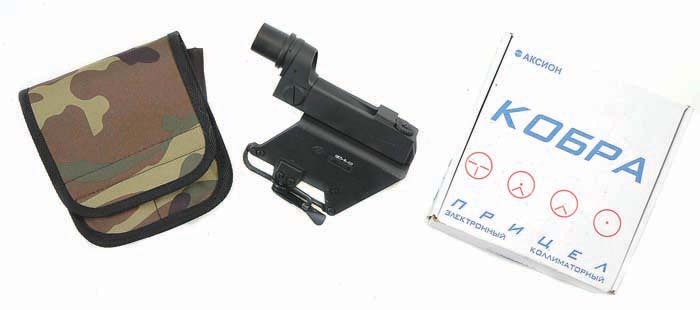
The Russian Kobra Collimator Sight
The Kobra sight is an open collimator combat optical device that has been fielded by the elite Russian Spetsnaz Special Forces and the Russian Internal Police. The Kobra uses laser technology to generate a red-dot, or several other reticle patterns, superimposed onto a clear filtered lens mounted on top of the weapon. The heads up display (HUD) of the Kobra was designed to be used with both eyes open. Kobra scopes have been continually improved and upgraded from feedback gained through combat experience in Chechnya. Early variations like the EKP-1S-01 utilized standard AA batteries that limited use of the device before the power supplied by the batteries would be expended. A new generation of the scope designated as the EKP-8-02 was designed. The new model has a redesigned frame and sight body and uses an easily obtainable CR series 3-volt lithium long-life battery for power. The earlier rubber sight hood has been replaced by a new plastic design formally only available for military use. In addition to the standard Russian side rail mount system, a new model has also been introduced for attachment on the popular Weaver and Picatinny type mounts that have been fielded on M16 and FN FAL rifles.
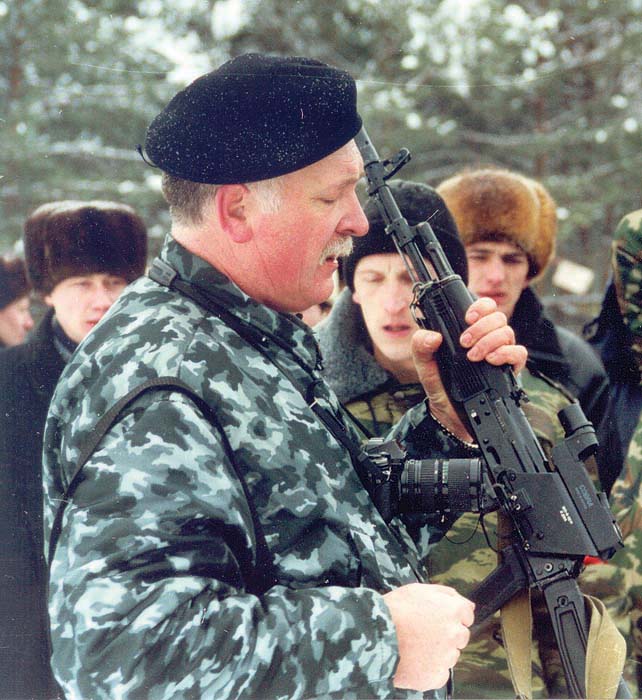
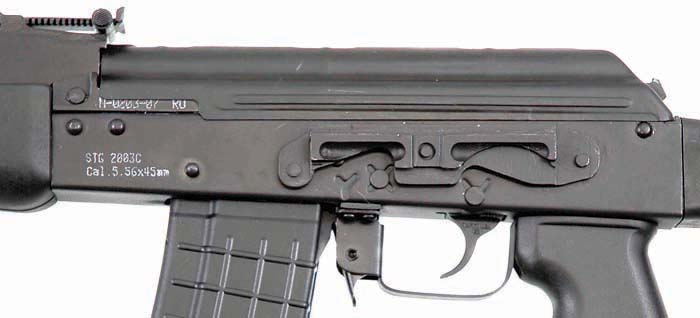
The sight is constructed for rugged military use from aluminum alloy and steel with a non-reflective flat black finish. A rotary style on-off switch is located on the left side of the unit to power up the reticle. There are four different reticle patterns for the operator to choose from: a dot, chevron, chevron with a dot or a T-bar. These are easily selected by simply pressing a small button that allows the operator to scroll through the patterns. The brightness of the reticle can also be easily adjusted as ambient light conditions warrant. To keep the scope reliable, a glass lens is used to protect the laser exit port.
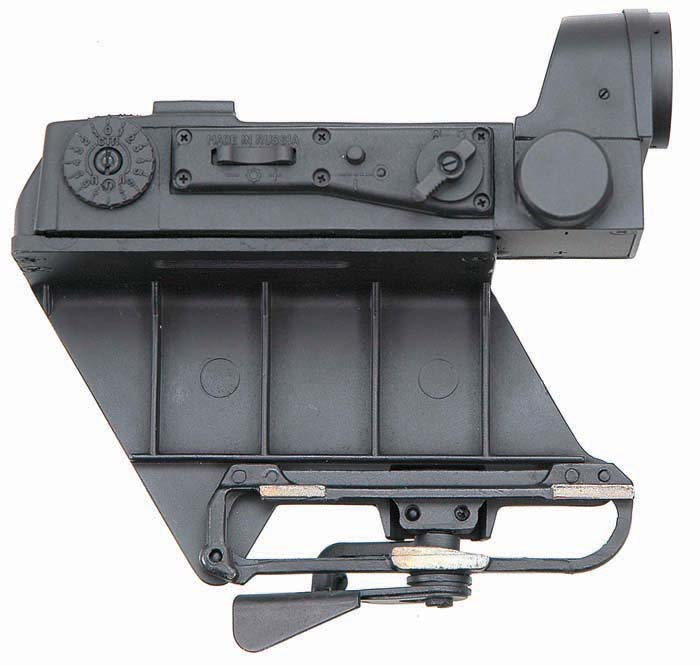
The sight is fully adjustable for elevation and windage. These adjustments are made by two separate wheels that are positioned on the top and on the right side of the unit. Both of the wheels are numbered from 0 to 7 in each direction. The adjustment wheels cannot normally be turned past the numeral 7, but if additional adjustment is needed to zero the scope, the tool provided can be used to loosen the slotted adjusting screw allowing the wheel to be removed from the stud and repositioned. Each number on the dial represents 3.1 centimeters at a distance of 100 meters, which translates to approximately 1.1-inches at 100 yards. Once the sight is zeroed, the wheels can be adjusted to read 0 for reference so that after subsequent adjustments the sight can be returned to the operator’s original zero adjustments. Adjustments to the reticle as it appears on the lens are virtually impossible to detect with the naked eye.
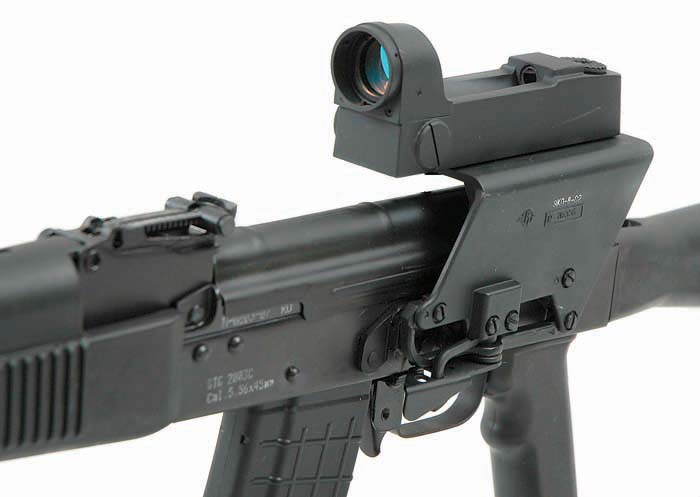
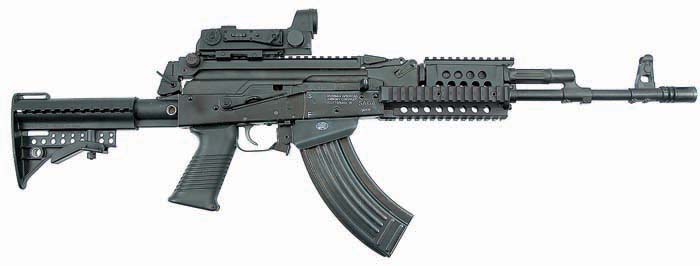
The Russian designed receiver mounted RSSAMS (Russian Standard Small Arms Mounting System) optics rail system and clamp system provides a solid mount for the scope allowing removal and reinstallation with no loss of zero once the sight has been adjusted to that rifle. The scope mount will fit on virtually any AK equipped with an optics rail. The sight’s mounting clamp is adjustable to allow for manufacturing deviations in any particular rail. If your AK isn’t equipped with a side rail they can be obtained from a number of sources. There are several designs on the market that are secured by rivets and others are available that can be secured to the receiver with screws.
SAR recently received one of Inter-Ordnance’s new STG-2003-C rifles for testing that had the Soviet-pattern optics rail riveted to the left side of the receiver. The STG-2003-C is a replica of the short-lived East German Wieger AK rifle that was chambered for the West’s 5.56x45mm (.223) NATO cartridge. It was decided to mount the Kobra scope on the STG-2003-C to see if it lived up to its reputation. The scope slid perfectly onto the rail and locked tight with no adjustments to the clamp. After firing several boxes of Wolf’s Classic Military 5.56x45mm cartridges to get the scope zeroed, we were ready to resume the evaluation.
The first thing one finds when using a red-dot scope of this type is getting acclimated to keeping both eyes open while aiming. At first this seems unnatural, but with some practice it is easily mastered and the effort is well rewarded.
Using the red-dot scope at a range of 50 meters, a target could be engaged and hit approximately 1.2 seconds faster than aligning the standard iron sights and aiming. Equally fast follow-up shots could be fired. As long as the red-dot was on the target, the bullet would strike where the dot was, even when the shooter’s eye was not perfectly aligned with the sight. If the dot was on the target, firing the rifle would score a hit and there were no parallaxes or eye relief problems. The reticle could be easily seen even in bright sunlight.
Also on hand for future test and evaluation by SAR was a highly modified AK provided by Mark Krebs of Krebs’ Custom. This rifle, chambered in 7.62x39mm, was fitted with a MIL-STD-1913 Picatinny rail used to mount the Weaver/Picatinny screw-mount model of the Kobra. The scope fit perfectly and after sighting it in gave the same performance as the rail-mount Kobra.
The Kobra scopes are manufactured in Russia by Izhevski Motozavod, Axion Holding Company, associated with Izhmash small arms works, and marketed in the U.S. by Kalinka Optics Warehouse. These are true mil-spec scopes made for the Russian military famous for insisting on simplicity, ruggedness and reliability. The Kobra has been battle tested by Russian Special Forces in Chechnya and is the perfect accessory for any AK owner interested in enhancing their target acquisition time.
The Kobra package includes the sight with integral clamp, lithium battery, adjusting tool, instruction manual, sun shield, lens cloth and Russian camo pattern storage/carrying case with belt loops. The Kalinka Optics Warehouse also offers a full 12-month factory warranty and 15-day, money-back guarantee.
Special thanks to: Kalinka Optics; Mike Eros at Kalinka Optics; Inter-Ordnance. Inc.; Mark Krebs at Krebs’ Custom; and Val Shilin
Kalinka Optics
254 Junco Circle
Longs, SC 29568, USA
http://www.kalinkaoptics.com/
| This article first appeared in Small Arms Review V11N8 (May 2008) |










